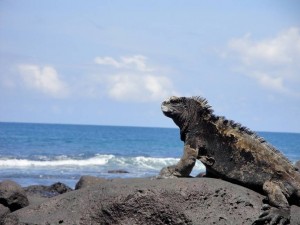
In the space of about three weeks in January, a group of Lafayette students and faculty will climb volcanoes in the Andean highlands, snorkel with sea turtles and sharks in the Pacific Ocean, and explore the Galapagos archipelago aboard seafaring vessels.
These South American adventures are part of an interim-abroad course, “Geological and Paleobiological Evolution of Ecuador and the Galapagos Islands,” taught by Provost Wendy Hill, Rappolt Professor in Neuroscience; Lawrence Malinconico, associate professor of geology and environmental geosciences; and David Sunderlin, assistant professor of geology and environmental geosciences.
The course is open to students from all majors and examines geological and biological concepts in an environmental context. Students will study how geological processes on land are related to the evolution of life.
“The high Andes and the Galapagos Islands are home to textbook examples of so many phenomena in natural history,” says Sunderlin. “To be there, on the rim of an active volcano or in the brush thicket with Darwin’s finches, actually observing phenomena that are so important to how humans now understand the world, is a powerful experience.”
In Ecuador, the class will witness the effects of multiple styles of volcanic activity within 600 miles of each other. The Galapagos Islands provide an opportunity to compare the effects of time on both biologic and geologic environments. The easternmost islands in the archipelago are about 4 million years old, but the westernmost ones are essentially brand new. As the class travels from the older to younger islands, they can see how each has aged.
“Our students will come to appreciate how closely linked geologic and biologic evolution actually are and perhaps appreciate how delicate the balance of nature is with the environment by understanding how easily the environments and consequently the biologic communities can be disrupted by the activities of humans,” Malinconico says.
While on the trip, students will face some interesting physical challenges. Their first destination, the Ecuadorian capital city Quito, is about 9,000 feet above sea level, and some activities, including hiking, may take them as high as 16,000 feet. Then they will return to sea level to explore the Galapagos. “I suspect that the students will be amazed with each environment by itself, but be particularly impressed with the differences between the highlands and the islands,” Malinconico says. “The change will be striking and exciting.”
“The unique isolation of the Galapagos has made these islands a remarkable showcase for the power of evolutionary processes,” says Hill. “Being able to discuss the adaptations and behaviors of such things as the lumbering, giant tortoises, colorful and unusual seabirds, and an amazing diversity of sea life while these animals are right in front of us, promises to be an exciting learning environment.”
Sunderlin says he is excited for the students to stand on the side of Guagua Pichincha, Sierra Negra, and the other volcanoes the class will visit. “These are sites of creation where molten rock solidifies to produce some of the highest peaks in the world. There the Earth seems to breathe as gasses waft up from fissures in the ground,” he says.
